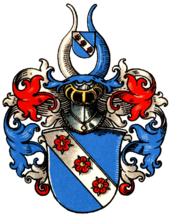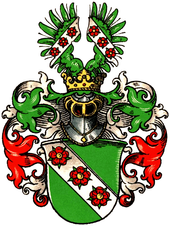Kerckerinck
Kerckerinck is the name of an old noble family from the Münsterland .
It consists of two lines:
- von Kerckerinck zur Borg, with the headquarters of Haus Borg in Rinkerode and
- from Kerckerinck to Stapel, with the headquarters at Haus Stapel near Havixbeck .
The presumably common origin of the two lines has not yet been clarified; both belonged to the traditional Münster heirmen .
Because of the name-like and also from Westphalia , but not related to the tribal Luebian patrician family, see under Kerkring .
from Kerckerinck to Borg
Presumably belonging to the Münster- Meinhoevel clan association, the family first appeared under the Münster hereditary family with Hermanus Kericherinc on May 26, 1264. Dominus Albertus Kerchering appears from 1292 to 1295 as Canon of Münster and Gottfried Kercherinc around 1380 (liber feudorum of the Bishop Florence von Muenster) as Burgmann of Horstmar . You acquire Bispinghoff immunity within Muenster with high jurisdiction in 1420 . Margaretha von Kerckerinck on the Bispinghof married Johann V. Droste zu Hülshoff (1421–1462).
The imperial and hereditary-Austrian baron class was awarded in Vienna on June 25, 1710 Jobst Stephan von Kerckerinck zur Borg , on Borg, Alvinghoff, etc., electoral Cologne Privy Council, war councilor and court marshal of the elector Clemens August from the house of Wittelsbach. By Prussia the baron status according to Min.-Reskr. of January 20, 1835 for Maximilian Klemens Freiherrn von Kerckerinck zur Borg, royal Prussian councilor in Trier , recognized.
Under Jobst Stephan's successor, Kaspar Nikolaus , the family got into a serious debt crisis and finally, in 1749, went bankrupt. It was not until 1782, under Caspar Nikolaus' son, Clemens August, that the bankruptcy proceedings could be ended.
The baronial family continues and has members in Germany and abroad. In 1978 the Haus Borg property, which had been in the family since 1466, was sold to the industrialist Dreier from Dortmund .
coat of arms
Kerckerinck zur Borg: In blue, a silver slanting bar on the right, covered with three red roses covered with gold. On the helmet with the blue and silver covers a small shield with the shield image between a silver and a blue buffalo horn.
from Kerckerinck to stacks
The baronial family died out in 1880. The tribe is continued by commoners as Sprickmann Kerkerinck , and Kerkering is still known as a family name. The oldest known ancestor is Godike von Kerckerinck, who bought Haus Stapel in 1467 and died in 1481. Son Bernhard (* 1462; † 1538), married to Margaretha, a daughter of Johann IV. Droste zu Hülshoff , and grandson Mathias (* 1515; † 1591) increased the property around the Giesking house. Mathias' older son Bernhard (* 1552) inherited Stapel, his brother Bertold (* 1554; † 1625) Giesking. It split the line temporarily.
coat of arms
Kerckerinck on the stack: In green, a silver slanting bar on the right, topped with three red roses covered with gold. On the helmet with green-silver covers an open eagle flight, covered with the shield image.
The Stapel branch
Bernhard's son Mathias (* around 1598, † 1661) remained unmarried, but had five sons. As illegitimate sons, they had to take up civil professions. A grandson of Matthias, Franz Bernhard Kerckerinck (* around 1670), became the monastery secretary at Nottuln . His son Franz Hermann (* 1700, † 1769) was secretary of the cathedral chapter to Munster and Gograf to beacon field ; his daughter Marianne Kerckerinck (* 1743; † 1791) married Dr. jur. Anton Matthias Sprickmann , a Westphalian poet and law professor.
Their son Christoph Bernhard Sprickmann Kerkerinck (* 1776, † 1852), also a professor of law in Münster was the Spitzenahn the still existing families Sprickmann Kerkerinck . According to Westphalian custom, because of his mother's land ownership - she was the last of her tribe - he was allowed to add her name to his. His grandson Rudolph Sprickmann Kerkerinck (* 1848, † 1905) was mayor of Rheine . The c in the middle of Kerckerinck's name had meanwhile been lost.
The Giesking branch
Bertold's son Bernhard (* 1596) had a son Matthias (* 1628; † 1684), bailiff of Kastellaun , who received the stack from his unmarried uncle Mathias (see above) after his death. His son Johann Ludwig von Kerckerinck zu Stapel (* 1671; † 1750) was the most ardent advocate of the Münster hereditary dispute, which lasted for several centuries and thus went down in history as the longest legal battle in Germany. It was only decided in 1709 by the judgment of Emperor Joseph I in Vienna in favor of the heirs.
Johann Ludwig von Kerckerinck zu Stapel obtained the hereditary title of baron at the imperial court in Vienna, both for himself and for his distant relatives at House Borg; afterwards he had the magnificent gate tower built on his seat at Haus Stapel .
His son was Franz Hermann Freiherr von Kerckerinck zu Stapel (* 1713; † 1778, Canon), his son Johann Franz (* 1739; † 1792, Canon). His daughter Maria Theresia Freiin von Kerckerinck zu Stapel (* 1786; † 1870) married Ernst Konstantin von Droste zu Hülshoff (* 1770; † 1841), the brother of Annette's father Clemens-August II of Droste , in 1801 - at the age of fifteen to Hülshoff . The couple now called themselves von Droste-Kerckerinck zu Stapel and had 22 children, none of which had (legal) offspring. Annette occasionally reports in her letters about the unloved Stapeler cousins whom she had to teach. The last descendant of the Kerckerinck, Ludovica Freiin von Droste-Kerckerinck zu Stapel, died in 1880, with which this aristocratic Kerckerinck branch died out and the Stapel family fell back to the Droste zu Hülshoff family .
According to tradition, a daughter from the 22-strong Stapeler group of children is said to have been impregnated by a servant from Havixbeck around 1820; the child - a son - was secretly given to a foster family in Nottuln , and there are indications that his descendants now live in Lorraine - with a family name that suggests Droste's ancestry .
Known family members
- Johann von Kerckerinck zu Stapel (1627–1700), Cathedral Vicar in the Prince Diocese of Münster
- Matthias von Kerckerinck zu Stapel (1628–1684), official resignation in Bruchsal and councilor of Mainz
- Heinrich Hermann von Kerckerinck zu Stapel (1632–1684), canon and dean in Fritzlar Cathedral
- Bertold von Kerckerinck zu Stapel (1640–1709), margravial court master and chamberlain and dean of the cathedral
- Wilhelm Lambert von Kerckerinck zu Stapel (1645–1676) court cavalier in Baden-Baden and Hesse and canons in Aschaffenburg
- Johann Ludwig von Kerckerinck zu Stapel (1671–1750), representative of the knighthood in the state parliament of the bishopric of Münster and fellow campaigner in the hereditary trial
- Jobst Stephan von Kerckerinck zur Borg (1679–1735), Oberhofmarschall of Cologne Elector Clemens August
- Kaspar Nikolaus von Kerckerinck zur Borg (1713–1746), Canon in the Prince Diocese of Münster
- Clemens August von Kerckerinck zur Borg (1720–1755), Chamberlain and Canon in Münster
- Maximilian von Kerckerinck zur Borg (1829–1905), Prussian district administrator
- Engelbert von Kerckerinck zur Borg (1872–1933), German manor owner, center party politician and agricultural lobbyist
literature
- Wilderich from Droste to Hülshoff : 900 years of Droste to Hülshoff . Verlag LPV Hortense von Gelmini, Horben 2018, ISBN 978-3-936509-16-8
- Wilderich from Droste to Hülshoff : Annette v. Droste-Hülshoff in the tension between her family. CA Starke Verlag, Limburg (Lahn) 1997, ISBN 3-7980-0683-0
- Genealogical manual of the nobility , Adelslexikon Volume VI, Volume 91 of the complete series, CA Starke Verlag, Limburg (Lahn) 1987, ISSN 0435-2408
- Rudolf Lückmann: Haus Giesking - history and architectural monuments , part 1 in: History sheets of the Coesfeld district, 15th year 1990. P. 81 ff .; Part 2 in: History sheets of the Coesfeld district, 16th year 1991. P. 43 ff.
- Sven Solterbeck: Blue blood and red numbers. Westphalian nobility in bankruptcy 1700–1815 . Münster: Waxmann Verlag 2018, ISBN 978-3-8309-3869-9 .
swell
- Sprickmann Kerkerinck family archive
Individual evidence
- ↑ Westphalian Document Book III, No. 725
- ^ Archives of the House of Borg, today owned by Josef Reichsfreiherr von Kerckerinck zur Borg
- ↑ Wilderich von Droste zu Hülshoff : 900 years Droste zu Hülshoff , Horben 2018, p. 55
- ↑ Sven Solterbeck: Blue blood and red numbers. Westphalian nobility in bankruptcy 1700-1815 . Waxmann, Münster 2018, ISBN 978-3-8309-3869-9 , pp. 168-184 .
- ↑ Wilderich von Droste zu Hülshoff : 900 years Droste zu Hülshoff , Horben 2018, p. 55




